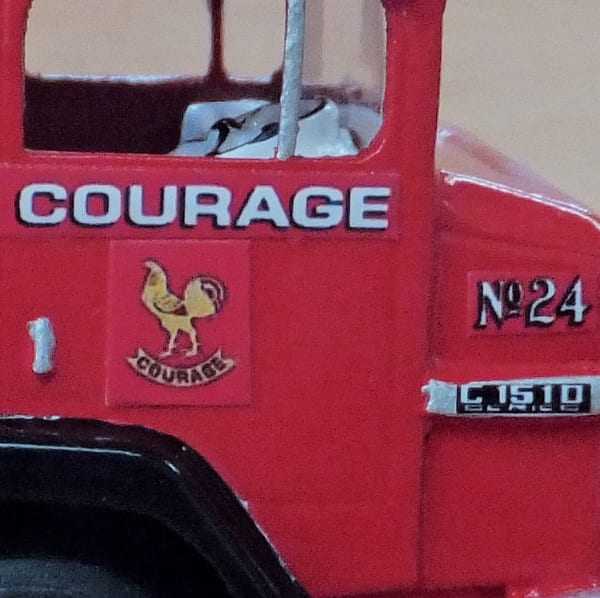‘Lindsay Fox Cartage’ began with one secondhand Ford F500. In 1966, the name was changed to ‘Linfox’. After winning the contract for Courage Breweries in 1968, the fleet then grew to 65 vehicles.
International released its AACO (Australian A-Line Cab-Over) series of trucks in 1961. The AACO 172 had a 264 cubic inch 6 cylinder petrol engine and the AACO 182 was equipped with the larger 282 engine, a 5 speed gearbox and a 2 speed differential, as standard.
By 1964, the styling was revised to include a one-piece windscreen in place of the original split screen, a mesh grille instead of the ‘bar’ style grille, and stronger steel mudguards in place of the fibreglass guards, with inbuilt step. The AACO 172 model was discontinued and a heavy duty AACO 184 with a 345 V8 petrol engine was introduced. The Perkins 6-354 diesel was optional and the chassis could be ordered as a 4 x 2, 6 x 2 (AACOT - ‘T’ for Tandem Trac) or 6 x 4 (ACCOF - ‘F’ for bogie drive). The ‘D’ prefix indicated a factory diesel, i.e., AACODT 182 or AACODF 184. This system continued for the later ACCO series.


In 1967, the cabs were updated with an all new bonnet, grille and single headlight setup. The cab, from the windscreen back, was the same as the previous AACO, but the front sheet metal was all new. This third series became the ACCO (Australian C-Line Cab-Over), and a twin-steer (8 x 4) version was released.
In 1968, big changes were introduced and the model range expanded. The front axle was relocated ten inches back, and the front doors were extended lower, with a step added between the bumper bar and door.
This type of ACCO became known as the ‘step down door’ or ‘long door’ ACCO. The 1967 types were then referred to as ‘short door’ ACCO’s. At the bottom of the range was the light duty C1510, which had 20 inch, 5 stud disc wheels (the same type used on the bonnetted C series trucks and Dodge AT4 5 series) and a downrated version of the 282 petrol engine called the 6-281.
International ACCO C2050
With the additional models in the range came a wide variety of engine choices: the 6-281 and 6-282 6 cylinder petrol; 345 V8 petrol; 392 V8 petrol; Perkins 6-354 diesel; Cummins V185 (185hp 470 cubic inch V8 diesel) and; Cummins V210 (210hp 504 cubic inch V8 diesel).
A new model designation system was introduced for the ACCO range, where the first two digits stood for the series and the third and fourth digits indicated the type of engine fitted as standard. The numbers ‘00’, ‘10’ and ‘20’ were used for 6 cylinder engines, ‘40’ for a V8 petrol engine, and ‘50’ for a V8 diesel. The models were C1510, C1600, C1820, C1840, C1950, C2050, and C2150.
The 345 V8 was optional for the C1820, the C1950 was equipped with the V185 Cummins (and had a unique bonnet with vent gills on top), and the C2050 and C2150 came with the Cummins V210.

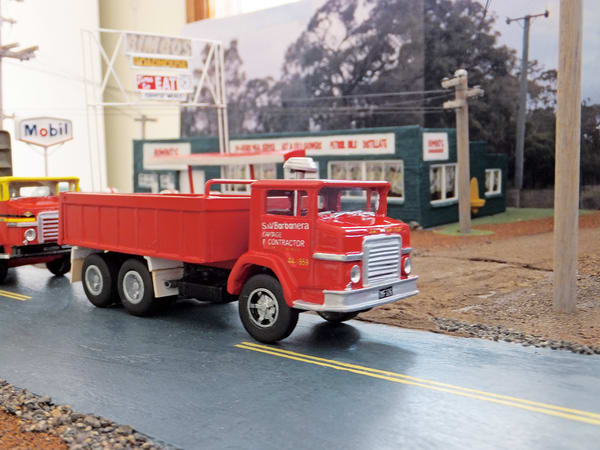
‘Sam’s Huff n Puff’
The ACCO C1840 with the number plate ‘IYF 326’, nicknamed ‘Sam’s Huff n Puff’, was operated by S&V Barbanera Cartage Contractors of Thornbury, Vic. This particular ACCO C1840 was retro fitted with a GM (Detroit) diesel and a C1950 - C2150 type air cleaner behind the passenger side of the cab.
From the factory, unless specially ordered, International trucks, up to the 1800 series, were supplied with black wheels, fuel tank and chassis. These were painted red for the 1900 and 2000 series, which had rounded fuel tanks instead of the normal rectangular type. A vented bumper bar was fitted to the 1900 and 2000 series, as well as C1840 trucks, when ordered with automatic transmission. The C2050 and C2150 had a unique grille with thicker slats to distinguish them from other models, although the standard grille was fitted to some early production vehicles.
When the ACCO-A series was introduced, the numbering system was further simplified to ‘10’ for the V8 petrol, ‘30’ for the 6 cylinder diesel, and ‘50’ for the V8 diesel, e.g., 1710, 1730, 1810, 1830, 1910, 1930, 2150.
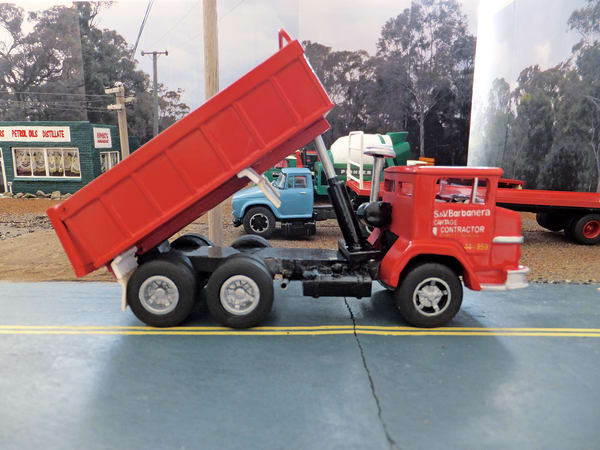

They are made in Australia
Although the C2050 and C2150 shared the same engine, the C2150 had a higher load capacity. However, according to the parts manual, the C2150 was only available as a 4 x 2 unit, whereas the C2050 could be ordered as a 4 x 2 (ACCO 2050), 6 x 4 (ACCOF 2050), or 8 x 4 twin-steer (ACCO 2050 TS).
The Linfox transport group employed owner drivers as well as its own fleet, so not only were there variations in the livery, but the range of trucks in service was very broad. Linfox acquired Armaguard from Mayne Logistics in 2003 and FCL in 2006, to become the largest privately owned supply chain solutions company in the Asia Pacific.
Today, Linfox operates in countries including Australia, New Zealand, Indonesia, Thailand, Malaysia, Vietnam, China, Hong Kong and India. Linfox is the second largest road freight company in Australia.
Bimbo’s Roadhouse was one of the ‘old timer’ truck stops along the (old) Hume Highway at Bargo, NSW, that began operating in the 1950’s.
That stretch of the Hume Highway, passing through Camden and Bargo, was part of the Great South Road that originally linked Sydney and Melbourne, with some parts of the route still using concrete sections that were laid in the 1920’s.
In 1825, convict gangs cut the first road over the Razorback Range, named because of its steepness. The (old) Hume Highway passed through Camden, Razorback, Picton, Tahmoor, Bargo, Yanderra, and on to Aylmerton until 1984, when it was bypassed by Rememberance Drive which links Sydney to Canberra.


There was an even older Hume Highway route from Picton that passed through Thirlmere, Hilltop and Colo Vale, which was realigned in 1928 to pass through Tahmoor and Bargo instead.
Bimbo’s Roadhouse at Bargo was located on the corner of Marshall Avenue which, at that time, was a dirt track. The roadhouse offered a meal service 24 hours a day, Chinese meals (even in those days!), hot or cold showers (which to choose?) and was a petrol station for Mobil. It is purported that ‘company’ in the hot showers may have been optional at extra cost.
Bimbo’s had 26 tables and seated 58. When that stretch of the Hume Highway was bypassed by Rememberance Drive, the necessity for a truckstop along that route diminished, and Bimbo’s Roadhouse eventually closed.



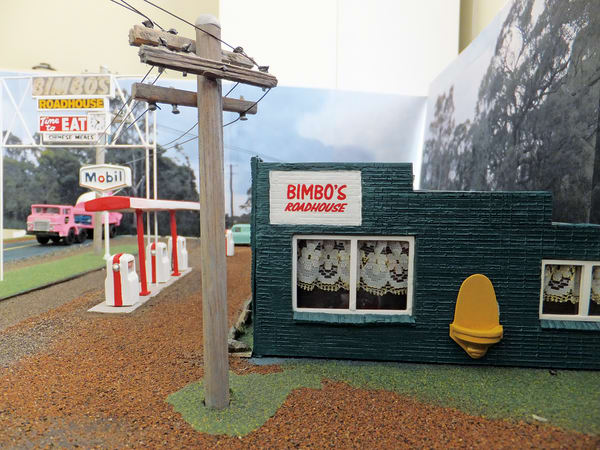


‘diesoleum’. A steak cost $1.70 and came with the choice of salad or vegetables, but if you ordered salad - the waitress brought vegetables anyway
Although the original building (now a pie shop and cafe) remains, there have been a number of changes which include the removal of the Mobil sign, bowsers and signage, the bowser slab has been built up into a decorative strip, and a large awning has been added which overhangs the former bowser and drive through areas.
There is a (quite humourous) review of Bimbo’s Roadhouse, written by Bluey Tucker, which was published in Truck & Bus Transportation Magazine, in 1974. The details and telegraph poles have been recreated using the photo of Bimbo‘s that appeared with the article. A T-bone steak would set you back $1.70 and a milkshake was 22 cents!



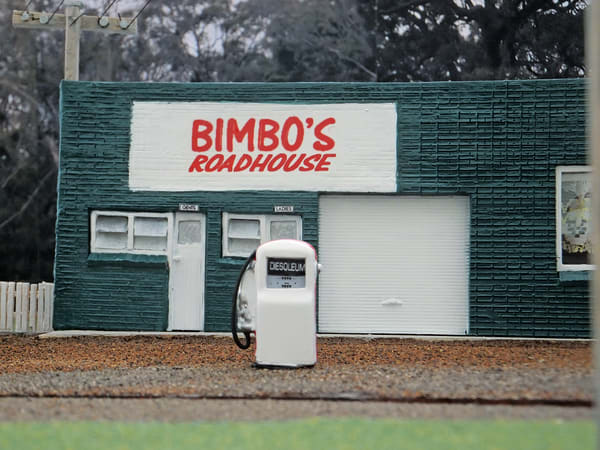
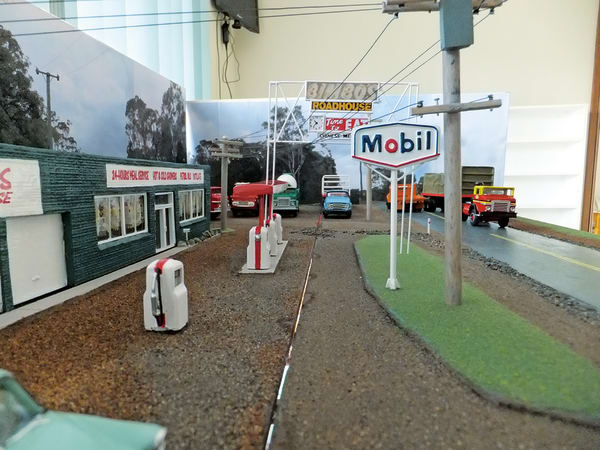


A great deal of research, site visits, conversations and ‘architectural archaeology’ were required to uncover the reason why most people could not recollect the colour of the building during the 1970’s - it was because it is the same as it is today!
For details on the 2013 range of handcrafted commercial vehicle models, please visit Rob’s Classic Models at: www.freewebs.com/robsclassicmodels or email: robsclassicmodels@gmail.com
Article and Images By Rob Bender


